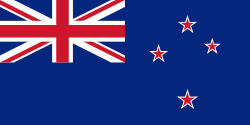South Wairarapa District (South Wairarapa District)
The South Wairarapa District is a district at the south-east tip of the North Island of New Zealand, governed by the South Wairarapa District Council. The district comprises the southernmost part of the Wairarapa, and is part of the Wellington Region.
The district comprises the floodplain of the Ruamahanga River and the associated Lake Wairarapa, as well as the long southern stretch of Palliser Bay. To the west of the plains rise the eastern slopes of the Remutaka Range, the crest of which forms the western boundary of the district, while the Aorangi Range lies to the southeast. The southernmost point of the North Island, Cape Palliser, is in the South Wairarapa.
While it is predominantly rural, the South Wairarapa has three towns. The two largest towns, almost identical in population, are Greytown and Featherston. Greytown is where Arbor Day was first celebrated in New Zealand. The Fell Locomotive Museum in Featherston has a museum displaying the world's only Fell locomotive. The third largest town and the seat of the district council is Martinborough; it is the centre of a nationally important wine-producing area.
It is expected that the number of people living in the district's urban areas will increase due to rising property prices in Wellington proper, and the proximity to transport links.
The district comprises the floodplain of the Ruamahanga River and the associated Lake Wairarapa, as well as the long southern stretch of Palliser Bay. To the west of the plains rise the eastern slopes of the Remutaka Range, the crest of which forms the western boundary of the district, while the Aorangi Range lies to the southeast. The southernmost point of the North Island, Cape Palliser, is in the South Wairarapa.
While it is predominantly rural, the South Wairarapa has three towns. The two largest towns, almost identical in population, are Greytown and Featherston. Greytown is where Arbor Day was first celebrated in New Zealand. The Fell Locomotive Museum in Featherston has a museum displaying the world's only Fell locomotive. The third largest town and the seat of the district council is Martinborough; it is the centre of a nationally important wine-producing area.
It is expected that the number of people living in the district's urban areas will increase due to rising property prices in Wellington proper, and the proximity to transport links.
Map - South Wairarapa District (South Wairarapa District)
Map
Country - New_Zealand
 |
 |
| Flag of New Zealand | |
The islands of New Zealand were the last large habitable land to be settled by humans. Between about 1280 and 1350, Polynesians began to settle in the islands and then developed a distinctive Māori culture. In 1642, the Dutch explorer Abel Tasman became the first European to sight and record New Zealand. In 1840, representatives of the United Kingdom and Māori chiefs signed the Treaty of Waitangi, which in its English version declared British sovereignty over the islands. In 1841, New Zealand became a colony within the British Empire. Subsequently, a series of conflicts between the colonial government and Māori tribes resulted in the alienation and confiscation of large amounts of Māori land. New Zealand became a dominion in 1907; it gained full statutory independence in 1947, retaining the monarch as head of state. Today, the majority of New Zealand's population of 5.1 million is of European descent; the indigenous Māori are the largest minority, followed by Asians and Pacific Islanders. Reflecting this, New Zealand's culture is mainly derived from Māori and early British settlers, with recent broadening of culture arising from increased immigration. The official languages are English, Māori, and New Zealand Sign Language, with the local dialect of English being dominant.
Currency / Language
| ISO | Currency | Symbol | Significant figures |
|---|---|---|---|
| NZD | New Zealand dollar | $ | 2 |
| ISO | Language |
|---|---|
| EN | English language |















